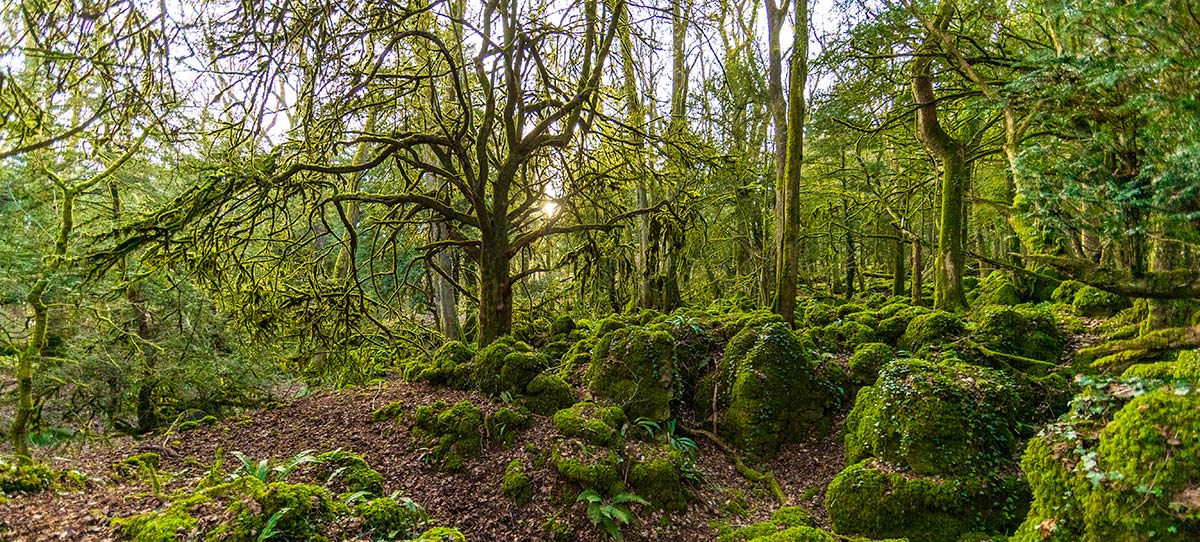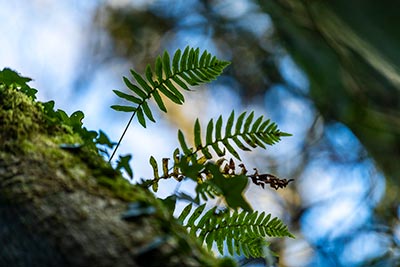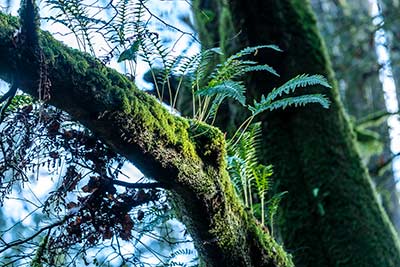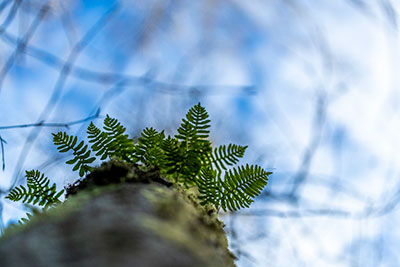
Puzzlewood is an Ancient Woodland, loved by many and described by Kathleen Kennedy, Star Wars Producer and President of Lucasfilm, as ‘the most magical forest on the face of the earth!'
Few people realise that Puzzlewood is a fragment of a very rare temperate rainforest, leftover from the days when such woodlands covered much of the UK west coast.

What is a temperate rainforest?
The clue is in the title; temperate as opposed to tropical, rain as in wet and forested. The strict definition seems to be up for debate among the experts, but the one constant in identifying such habitat is that it is so wet that plants can grow on other plants. These are called epiphytes and they are spread across the world in wet forested environments. One key indicator species for temperate rainforests is the Common Polypody fern (Polypodium vulgare).
Temperate rainforests, damp, dense woodlands in cooler climates are one of the rarest habitats in the world. They didn’t use to be. They used to be abundant but since we became 'civilised', you’ll be unsurprised to hear that they are no longer easy to find.
Come with me while I take you on a walk through Puzzlewood looking for Polypody ferns. After just a short walk, I spy my first one. I crane my neck upwards for a closer look and sure enough, there is that distinctive ladder shaped leaf frond jutting out from an Ash tree.
I find more growing amidst moss on a branch and then a whole group of them basking in the morning sunlight atop a vast moss-covered limestone landmark.

Whole mini colonies of plants grouped together wherever their spores fell on the wind. Some typically high up on a tree stem, some on a fallen moss-covered branch and some even growing apparently straight out of the rocks.
When you visit, look up to the top of the cliff towering over the boardwalk valley, you’ll see the tell-tale ladder like shape of this delicate little plant blowing in the gentle breeze.
They are easy to see here, backlit by the sky above. And, now once you have your eye in, you’ll start to spot them everywhere. They form themselves into little colonies so if you have seen one, take some time to look more closely for its neighbours on the same or nearby trees.
At Puzzlewood these delicate and beautiful evergreen little ferns have found that sweet spot so reliably wet that they can grow on other plants, trees, rocks or just about anywhere they wish.

Why might this ecological gem have survived? There are several factors to consider when we think about the health of any woodland. The first and most obvious are people, chopping everything in sight down to the ground, grazing sheep and deer, and growing crops.
Puzzlewoods unique terrain of Scowles makes any commercial farming impractical, and has acted like a fortress.
The external pressures on our temperate Rainforests are still at play however. We can prevent anyone from coming onto Puzzlewood and chopping down trees, and encouraging people to stay on the paths, but it's harder to address the impact caused by what is happening around us.
The effect of Climate Change on our temperate rainforests is extremely worrying, and could seriously impact Puzzlewood in the next 30 years which is nothing in the lives of our trees.
Closer to home, we have industrialised poultry rearing units that believe they can operate outside of planning consents and conditions, using their financial and legal clout to push their polluting practices onto the environment, endangering the local ecosystems.
A healthy forest is not a tidy place. It’s not meant to look like a landscaped garden. Standing dead wood and leaf litter are vital elements to the long term health of woodlands.
Puzzlewood has long employed a policy of only cutting that which might be unsafe for visitors. It's a delicate balance of protecting the environment and making the woods safely accessible.
Although Puzzlewood is at the very edge of the UK temperate rainforest zone, its location between the vast estuary of the River Severn and the Wye Valley does have an effect in drawing the damper conditions up river and into the wider Forest of Dean.
We have these westerly facing woodlands looking into the prevailing weather bringing this damp atmosphere to our woodlands. Added to that as you’ll find when visiting, as I have been often privileged to experience, Puzzlewood creates its own micro climate. The sudden drop in temperature on entering the woods in high summer is a pleasure to cherish. In addition, although worked for iron ore in Roman times the same difficult terrain may have prevented widespread clearance like many other areas of wildwood immediately around it.

The micro climate in Puzzlewood combined with the steep sides and gullies of the erosion areas can mean that rainfall that does fall is sheltered from the summer heat of the sun and strong winds and so persists keeping the woods wetter for longer. The limestone itself is also porous and may also hold more of that rainfall. Puzzlewood is also very different from the “Atlantic oakwood”, as these areas used to be called, in that it is unusually a very dense Yew woodland which is evergreen and Puzzlewood has a degree of tree canopy through the late autumn and winter.
A thriving Yew and mixed woodland, an abundance of healthy mosses and liverworts growing on rocks, fallen timber and festooning the tree branches, a very healthy Lichen flora, including Beard lichens,and very healthy Polypody ferns growing in colonies dotted around Puzzlewood.
If you visit and find a new colony, please take some pictures and let us know so that we can map and conserve it. PLEASE, always remain on the paths. They are there primarily for your safety in this rugged landscape, but more importantly, they are also the reason that the woodland is in such a relatively pristine state.







